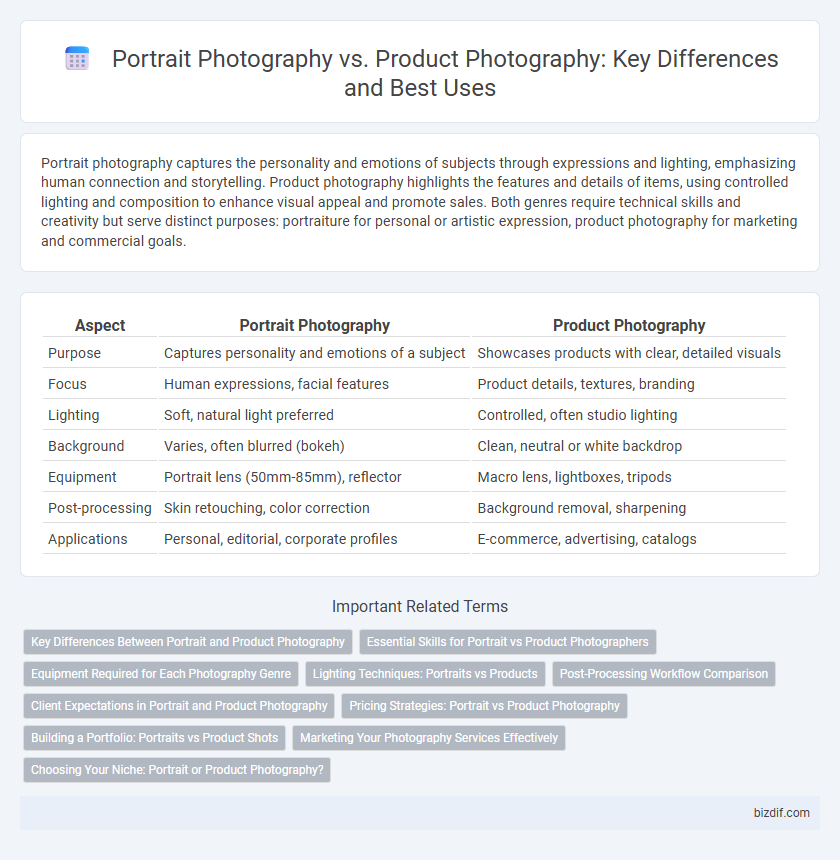Portrait photography captures the personality and emotions of subjects through expressions and lighting, emphasizing human connection and storytelling. Product photography highlights the features and details of items, using controlled lighting and composition to enhance visual appeal and promote sales. Both genres require technical skills and creativity but serve distinct purposes: portraiture for personal or artistic expression, product photography for marketing and commercial goals.
Table of Comparison
| Aspect | Portrait Photography | Product Photography |
|---|---|---|
| Purpose | Captures personality and emotions of a subject | Showcases products with clear, detailed visuals |
| Focus | Human expressions, facial features | Product details, textures, branding |
| Lighting | Soft, natural light preferred | Controlled, often studio lighting |
| Background | Varies, often blurred (bokeh) | Clean, neutral or white backdrop |
| Equipment | Portrait lens (50mm-85mm), reflector | Macro lens, lightboxes, tripods |
| Post-processing | Skin retouching, color correction | Background removal, sharpening |
| Applications | Personal, editorial, corporate profiles | E-commerce, advertising, catalogs |
Key Differences Between Portrait and Product Photography
Portrait photography captures the personality and emotions of a subject through expressive poses, natural lighting, and background choices that enhance human features. Product photography emphasizes clarity, detail, and accurate color representation using controlled lighting, sharp focus, and minimalistic backgrounds to highlight the product's features. While portrait photography aims to create a connection with the viewer, product photography focuses on showcasing the product's functionality and appeal for commercial purposes.
Essential Skills for Portrait vs Product Photographers
Portrait photographers must excel in interpersonal communication, natural lighting techniques, and emotional expression capture to convey personality and mood effectively. Product photographers require mastery of controlled lighting, macro photography, and post-processing skills to highlight intricate details and textures of objects. Both disciplines demand a strong understanding of composition and technical camera settings, yet their focus diverges with portraits prioritizing human connection and products emphasizing clarity and visual appeal.
Equipment Required for Each Photography Genre
Portrait photography requires cameras with high-resolution sensors and lenses with wide apertures, such as 85mm f/1.8 or 50mm f/1.4 prime lenses, to achieve sharp focus and pleasing bokeh effects. Product photography benefits from macro lenses and controlled lighting equipment, including softboxes and light tents, to highlight fine details and eliminate shadows. While both genres rely on tripods and reflectors, product photography often demands more precision lighting setups for consistent results.
Lighting Techniques: Portraits vs Products
Portrait photography employs soft, directional lighting to sculpt facial features and create mood, often using diffusers and reflectors to achieve natural skin tones and expressive shadows. Product photography relies on even, controlled illumination with light tents or multiple light sources to eliminate shadows and highlight textures, ensuring accurate color representation and detailed visibility. Mastering the contrast between dynamic portrait lighting and consistent product lighting enhances visual storytelling and brand identity.
Post-Processing Workflow Comparison
Portrait photography post-processing prioritizes skin retouching, color grading, and enhancing facial features to achieve natural yet polished results, often using tools like frequency separation and dodge and burn techniques. Product photography editing emphasizes color accuracy, background removal, shadow creation, and sharpness to highlight product details and maintain brand consistency, with frequent use of masking and compositing methods. Both workflows require precise adjustments, but portrait editing focuses on human aesthetics while product editing centers on clarity and presentation of inanimate objects.
Client Expectations in Portrait and Product Photography
Portrait photography clients expect personalized images that capture individual personality, mood, and emotions through controlled lighting and composition. Product photography clients prioritize clarity, accurate color representation, and detailed focus to enhance the product's appeal for e-commerce and advertising platforms. Meeting these distinct expectations requires tailored techniques and communication to ensure client satisfaction in each photography niche.
Pricing Strategies: Portrait vs Product Photography
Portrait photography pricing often varies based on session length, number of subjects, and post-processing complexity, with packages ranging from $150 to $500 per session. Product photography pricing depends heavily on factors such as the number of items, image usage rights, and retouching requirements, typically costing between $25 and $200 per image. Understanding client needs and market standards is critical to setting competitive prices for both portrait and product photography services.
Building a Portfolio: Portraits vs Product Shots
Building a portfolio for portrait photography emphasizes capturing diverse expressions, emotions, and lighting styles to showcase versatility in human subjects. In contrast, product photography portfolios highlight crisp details, accurate color representation, and creative styling to attract commercial clients. Both require a consistent theme and high-quality images that demonstrate technical skills and artistic vision.
Marketing Your Photography Services Effectively
Portrait photography emphasizes capturing personality and emotion to build strong client connections, while product photography highlights the details and appeal of items to drive sales. Marketing your photography services effectively requires tailoring your portfolio and messaging to target audiences, showcasing your expertise in either creating compelling human stories or visually enticing product images. Leveraging social media platforms and SEO strategies tailored to portrait or product niches increases visibility and attracts potential clients seeking specialized photography solutions.
Choosing Your Niche: Portrait or Product Photography?
Choosing your niche in photography hinges on your passion and skill set, as portrait photography demands emotional connection and capturing personality, while product photography requires precision in lighting and detail to highlight features. Portrait photographers often excel in interpersonal communication and creative expression, whereas product photographers prioritize technical mastery with studio equipment and post-processing to enhance brand appeal. Understanding market demand and your unique strengths helps determine whether to specialize in portrait or product photography for a successful career.
Portrait Photography vs Product Photography Infographic

 bizdif.com
bizdif.com